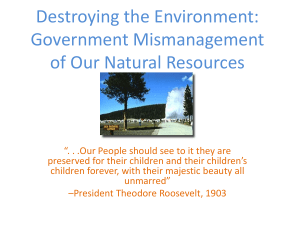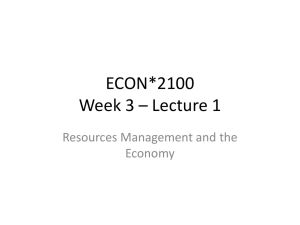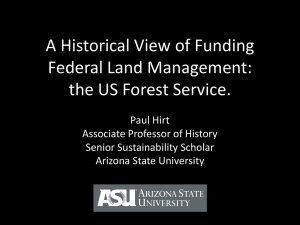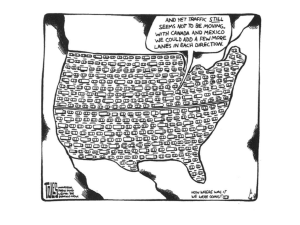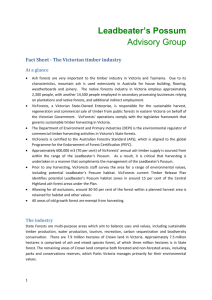Cost Benefit Analysis - Forest and Conservation Economics
advertisement
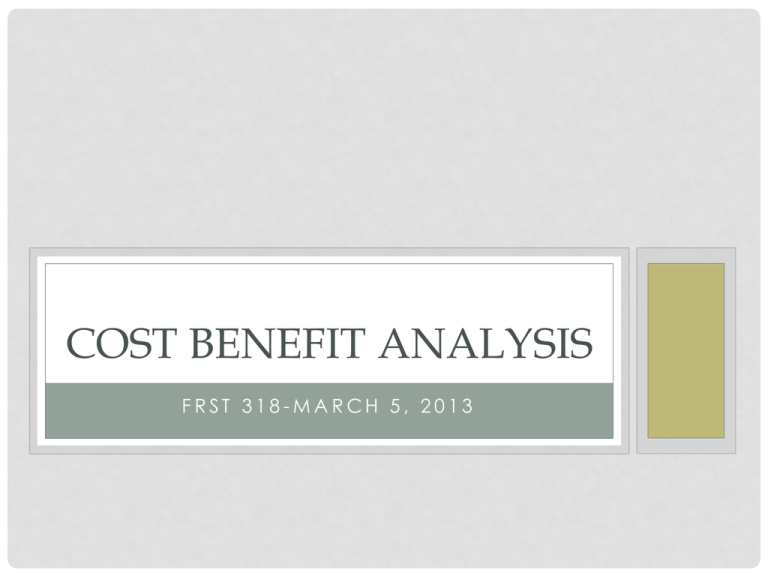
COST BENEFIT ANALYSIS FRST 318-MARCH 5, 2013 WINNING BID! ! Licence Number: A 89069 * February 28, 2013 A89069 Closing Time:*11:00 am Opening Time:11:00 am Geographic Area: McNeil Lake BCTS Area: Strait of Georgia (Campbell River) District Area: Sunshine Coast Volume: 22,349 m3 Term: 12 months Species: Hem 43%, D-Fir 35%, Ced 18%, Ald 4% Upset Stumpage: $21.60 Tender Type: Bid Tender (sec 20) Category: Cat 1,2 or 3 Stand Type: 86% 2nd Growth Logging System: Hoe Forwarding silviculture: CCWR, Windfirm treatment Season: Dry Season Road Building: New rd. construction 1.8 km Sechelt/ Hwy 101/ Menacher Rd./ McNeill Lake FSR/ MNL034 Contact:Mike Romalis(604)485-0717 Avg Piece Size: .90 m3/tree Net merch 717 m3/ha. 32.8 ha area. 3,669 m3 non-competitive($.25)(no bonus) 4 Blocks Comments: *Amendment#1 changed closing Feb.7 to Feb.14 *Amendment #2 extends closing Feb.28, 2013. (1.7 ha BLK nearest McNeil Ll. was deleted) *Amendment #3 includes the tender package documents to be used. Amendment #4 Replaces TSL document. Access: February 22, 2013 February 20, 2013 February 12, 2013 January 09, 2013 Order Bidder Bid Total 1 BURN DRY WOOD $7.23 $28.83 2 JFI FORESTRY $4.38 $25.98 ! ! ! ! Bid History WHAT IS COST-BENEFIT ANALYSIS? • Cost-Benefit analysis is used to evaluate public actions and decisions • Goal is to provide information on what action provides society with the most economically beneficial use of its resources (Loomis 1993 in Ward 2006) • Converts costs and benefits into a common denominator (most often money) APPLICATION • Can evaluate introduction of regulation; or consideration of alternative instruments (tax, regulation); • programs-for example green transformation (what Mark mentioned); • projects • The analogy to the private sector-instead if revenues to a private firm, CBA substitutes benefits to society; and instead of private costs for the firm; CBA substitutes opportunity cost; and the equivalent of profit is benefit minus cost DECISION RULE • A simple decision rule-benefits must exceed costs • Comparing different actions with same goal, the one that provides the highest net benefit is the preferred action and should be adopted if economic efficiency is the goal • Other criteria • • • • equity administrative ease Transparency Predictability of implementation ESTABLISHING ASSUMPTIONS AND SCOPE • Analysis should consider all those people and values affected • Goal is to capture all benefits and costs regardless of to whom they accrue • International not typically included unless these are meant to be specifically evaluated • Unless specifically restricted should span sectors and contingent costs • Benefits and costs should be measured with the program versus without it ALTERNATIVES • Cost Effectiveness analysis • Where benefits difficult to measure or quantify or undesirable to do so (i.e. lives saved, endangered species) • Multi-criteria Analysis • Set of criteria against which policy options are evaluated • Environmental Impacts Assessment • Provides raw information, with no common value-some prefer because it does not assign values http://paperdarts.org/storage/1500JoeUchill-High-school-popularity-Acostbenefit-analysis.png An example of multi-criteria analysis for a major information technology project where scores are out of a maximum of 100 might look something like the following: Table 4.5: Multi-Criteria Analysis Example Unweighted Scores (out of 100) Criteria [weight] In-house Supplier 1 Supplier 2 NPV [60%] 20 100 65 Robustness [20%] 82 90 96 Flexibility [20%] 80 50 78 44.4 88 73.8 Overall Weighted Average In this case, supplier 1 is likely to be the preferred option. Importantly multi-criteria analysis provides decision-makers with an audit trail as the results are transparent, explicit and documented. 4.7 Concluding Comments Decision-makers need a consistent basis for assessing competing proposals and to be fully informed about the implications of using economic resources. By quantifying all significant costs and benefits in monetary terms it is possible to determine the net benefits or costs of a given proposal. However some significant benefits or costs may be subject to uncertainty and/or may not be able to be quantified in monetary terms. This chapter has outlined a number of analytical tools to unable analysts to assess the effects of risk and uncertainty, and to allow decision-makers to make informed trade-offs between the quantitative and qualitative factors that would influence the choice of OWLS VERSUS DOLLARS The Policy Question • Should we reduce old growth logging to protect more spotted owl habitat? • Note that we could frame and answer this question in several ways, especially in regards to the prospects of seeing a species become extirpated CONSTRUCTING THE CBA FRAMEWORK Executive Summary The spotted owl is one of British Columbia’s most endangered species and its population is dwindling as logging continues in the coastal old growth forests upon which it depends for survival. Many other species depend on this habitat, some of which are endangered as well, and old growth forests provide a host of other benefits to humans. The two major land use options at issue are logging or protection of these old growth habitats. Protection of old growth forest carries an opportunity cost in terms of the foregone surplus (producer surplus or economic rent) from timber harvesting. However, the harvesting of old growth timber carries an opportunity cost in terms of other foregone values, such as certain recreation opportunities, stored carbon and ecosystem services (e.g. watershed protection). The goal of this study was to take a first step towards a rigorous examination of the main land use coastalthe oldheight growth with the intent of determining oneowl is optimal haveoptions not yetfor reached andforest structural requirements to constitutewhich spotted habitat. for society. We do not estimate the value of all costs and benefits associated with the different land use instead, we focus on the forest values related to timber, Theoptions; net forest value estimates areestimating present values for a stream of annual benefitsnon-timber over a 100 forest year products, recreation and carbon sequestration/storage. We do not attempt to estimate other period. Once the net forest values are estimated for each of the three scenarios, the opportunity ecosystem services as watersheds, nutrient control ofscenarios soil erosion. The study cost associated withsuch implementation of either ofcycling, the two and preservation is calculated as assesses the opportunity costs of preservation of old growth forests with adjustment for these the difference in net forest value between the preservation scenario on question and the baseline selected benefits from preservation. such, is concerned with spotted scenario.potential We include sensitivity analyses for As many of the our study parameter assumptions, such as owl log conservation but not exclusively so. prices, harvesting costs, the shadow price of carbon and the choice of discount rate for adjusting future values. The study methodology involves an economic analysis of preserving old growth forest habitat, based on welfare economics criteria. wereofable to use forest data generated frombe a spatioOur results suggest that under a broadWe range parameter assumptions there would a net temporal model designed by Gowlland Technologies and forest management scenarios benefit rather than an opportunity cost associated withLtd. increased preservation of old growth previously by the Spotted Owl Recovery Cortexrecreational Consultants and forests. In designed other words, theCanadian benefits of preservation in terms Team, of increased Gowlland Technologies forforest their products, recent report, A Framework to Support Landscape Analyses opportunities, non-timber and carbon sequestration and storage outweigh the of Habitat Supply and Effects on Populations of Forest-dwelling Species: A Case Study Based on costs in terms of lost producer surplus from timber harvesting. The only exception occurs when the log Northern prices areSpotted allowedOwl. to rise in future and a low value for sequestered carbon is used; in this case, the opportunity cost turns positive. For most set of assumptions, however, our estimates Our study considers a specific forest area, the Fraser Timber Supply Area (TSA), which is SELECTED VALUES • • • • Timber Carbon Recreation Non-timber forest products METHODOLOGY • Three scenarios are established • Values are measured over a 100 year period and summed up • Sensitivity Analysis is used for the three most important variables • Timber prices, carbon prices, and discount rate • Timber harvest simulation model is used to calculate changes in forest growth, forest volume, and total timber stock SCENARIOS • Maintaining Current Approach (SOMPcurr) • Specific area preserved can change so long as 67% of productive forest within long term activity centres is 100 years old • Preserving 100% of existing suitable stands are preserved (SUIT100) • Habitat is expanded (TERR100) • Packed territories are defined where contiguous areas of suitable habitat are not harvested MEASURING TIMBER VALUES • Measure producer surplus • Rely on market values for log prices and harvesting costs • The difference is producer surplus LOG PRICE ASSUMPTIONS RECREATION VALUES 4.2.1 Consumer Surplus from Outdoor Recreation We measure the benefits to recreationists from the forests of the Fraser TSA as their consumer surplus (see Chapter 3). For recreation, consumer surplus is the difference between how much consumers value outdoor recreation and how much they spend on outdoor recreation. There are many different methods for estimating consumer surplus, the most common of which is the contingent valuation method. Consumers are asked how much they would be willing to pay in a hypothetical market for outdoor goods, such as wildlife habitat and provincial parks, over and above their expenditure on equipment, travel, and fees or licenses. There have not been any contingent valuation studies done for BC provincial forests in the last decade, so we use estimates from the Outdoor Recreation Survey 1989/90 to form an estimate of current willingness to pay. This survey covered recreation activities on provincial forests, which coincides with the area being analyzed in this report, the Fraser TSA. MEASURED VALUES • Consumer surplus from outdoor recreation • Adjusting these values for forest harvesting • Hunting ($0.82 per ha) • Water-based and human-powered recreation activities ($59.70 per ha) Angling camping, hiking, backpacking paddling, skiing and snowshoeing hot springs motorized activities hunting MEASURING NTFP’S • Commercial Mushroom harvesting (producer surplus) ($1.27 per ha) • Recreational mushroom picking (consumer surplus from hiking plus market value) ($0.45 per ha) • Floral greenery and other NTFP’s (no value assigned) MEASURING CARBON VALUES • Two main carbon flows • Carbon sequestration and storage through net timber growth • Also carbon emissions from timber harvesting • Here only looked at decay of timber products • Did not look at changes in carbon content in the soil and understory biomass, carbon emissions during harvesting VALUING CARBON • Pick three values to test sensitivity of results • $20, $75, and $150 • Assume different decay rates for timber products • 38% becomes construction lumber (5% loss 1st year, then approximately 1% thereafter) • 16.3% other type of lumber (40% 1st year, then approx. 1%) • 45.7% becomes chips (50% 1st year, then 9% for next 5 years) • So net value of Carbon for each scenario equals that sequestered over the period minus the losses RESULTS FOR ONE SET OF ASSUMPTIONS BREAKING DOWN THE COMPARISON 1%, rising log prices In this scenario it does not make sense to reduce harvests; note that Baseline scenario has highest value Timber Revenues Costs Producer surplus Hunting Other recreation NTFP's Carbon ($20) total Amount by which SOMPcurr is bigger (smaller) SOMPcurr SUIT100 Terr100 7747.8 5220.5 5039.8 7020.5 4883.2 4732.4 Amount by which SOMPcurr is bigger (smaller)(for Terr100) 727.7 337.3 307.4 420.3 15.11 14.81 14.55 0.56 3404.5 3515.2 3544.9 -140.4 28.04 25.81 28.16 -0.12 -3.8 4171.55 111 4004.12 131.8 4026.81 -135.6 167.43 144.74 144.74 ANSWER • Yes, that we should reduce old growth logging • They find that the economic benefit of preserving more old growth (which leads to lower harvest levels) yields greater economic benefits • They do not attach any value to the spotted owl SENSITIVITY ANALYSIS Table 4.5 Summary of Parameter Assumptions Parameter Units Value Old Growth Log Prices Cedar Douglas fir HemBal Pine/larch Spruce Deciduous $/m³ $/m³ $/m³ $/m³ $/m³ $/m³ 135.83 104.10 61.72 43.83 85.61 60.00 Second Growth Log Prices Cedar Douglas fir HemBal Spruce $/m³ $/m³ $/m³ $/m³ 121.08 75.85 54.05 63.83 Harvesting Costs $/m³ 79.98 Average per hectare Recreation Values Hunting Water-based and human-powered $/ha $/ha 0.82 59.70 Non-Timber Forest Products Commercial harvesting Recreational harvesting $/ha $/ha 1.27 0.45 $/tonne 20, 75, 150 % 1, 4, 7 years 100 Shadow Price of Carbon 32 Discount Rate Time Horizon for Modeling in the region or country. Are all the costs and benefits realisticall y valued? Use the previous points to assess whether you have either overvalued the benefits or undervalued the costs. If you have had to rely on figures provided by those promoting the project, check them for the optimism bias. Seek evidence of benefits and costs from reputable sources. SENSITIVITY ANALYSIS If the NPV is very high, why hasn’t the proposal been implemented earlier? If the NPV is very large, a useful check is to ask why it hasn’t been done earlier. A large NPV suggests a very high return, and possibly higher than the existing programmes. Are there any variables that really influence the results? Often there are one or two variables (prices, values, capital cost) that drive the whole project, usually the capital cost of the project and the level of benefits. As these costs/benefits can be hard to estimate, you can check the robustness of the analysis by undertaking a sensitivity analysis, which is simply a second analysis with a sensitive variable changed by ±10% or ±50% or whatever is a realistic and possible variation. If the benefits of a project are uncertain, a sensitivity analysis will show the impact on the NPV of (say) a 100% variation to the estimated benefits. If the NPV remains positive or negative (whichever is the case) despite the change in the assumption, you can be much more comfortable of the robustness of your result. Have you considered too few options? Decisions where there are no realistic choices are rare. There is always the “do-nothing”/“status quo” option and there will usually be choices as to the size, scope, form, or timing of projects. It is important that options are not ruled out solely because of differences in technical performance without an examination of comparative costs. 60 http://www.dpmc.govt.nz/cabinet/guide/index.html COST BENEFIT ANALYSIS PRIMER – DEPARTMENTAL CFISNET RELEASE | 43 Table 4.5 Summary of Parameter Assumptions Parameter Units Value Old Growth Log Prices Cedar Douglas fir HemBal Pine/larch Spruce Deciduous $/m³ $/m³ $/m³ $/m³ $/m³ $/m³ 135.83 104.10 61.72 43.83 85.61 60.00 Second Growth Log Prices Cedar Douglas fir HemBal Spruce $/m³ $/m³ $/m³ $/m³ 121.08 75.85 54.05 63.83 Harvesting Costs $/m³ 79.98 Average per hectare Recreation Values Hunting Water-based and human-powered $/ha $/ha 0.82 59.70 Non-Timber Forest Products Commercial harvesting Recreational harvesting $/ha $/ha 1.27 0.45 $/tonne 20, 75, 150 % 1, 4, 7 years 100 Shadow Price of Carbon 32 Discount Rate Time Horizon for Modeling ALLOWABLE CUT EFFECT (ACE) • The Allowable Cut Effect exists where there are regulations or policies that constrain harvest levels • Examples in BC are the metering out of old growth timber (key for it to work) • Improvements in growth and yield are spread out over the entire rotation • Conversely losses in timber are also spread out (regardless of whether or not timber was close to harvesting age) USING ACE AS AN INCENTIVE A New Silviculture Framework for British Columbia: Options and Recommendations Report Prepared by Resource Practices Branch Ministry of Forests, Lands and Natural Resource Operations May, 2011 EFFECT OF ACE Standard CBA Effect of ACE • Cost of improving the stand -$1000 per hectare • Result-doubling of growth (an additional 995 cubic metres) • Standard cost-benefit: • If you can take additional volume over the 58 years… ($13,187/58) • Discounted Benefit: $13,187/1.0558=$778 • Cost: $1000 • So NPV =-$222 • Then it looks quite different • Using a formula-the present value of a finite annuity • Result with ACE • Discounted benefit = ($13,187/58)*((1.05)581)/.05*(1.05)58 = $4,546 • Same cost but NPV=$3,546 EXPERIENCE WITH ACE
